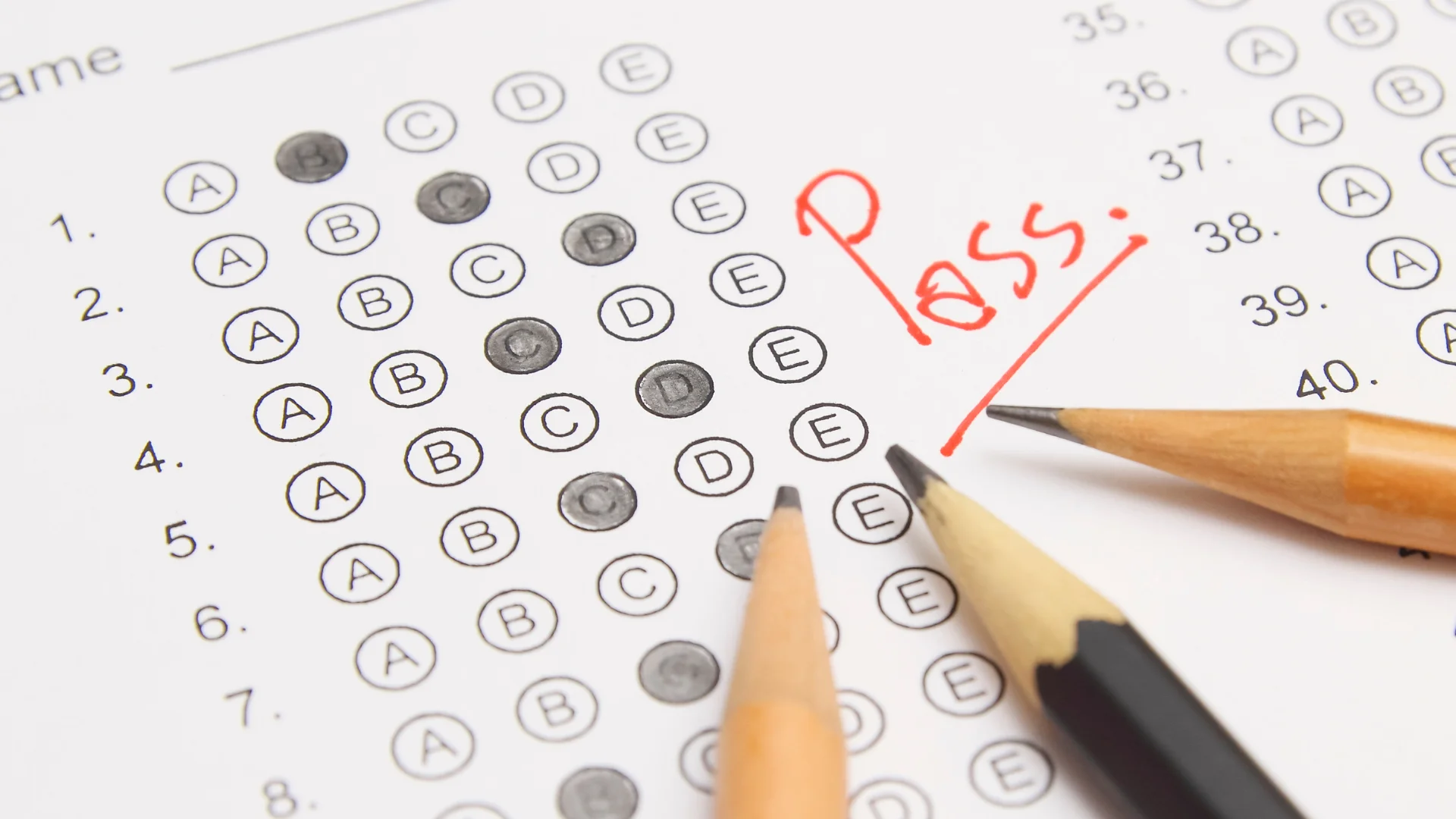The SAT is still one of the most talked-about parts of the college application process. A strong score can open doors, boost your chances at competitive schools, and even lead to scholarship opportunities. But with test-optional policies, shifting score ranges, and a new digital format, it’s easy to feel confused about what “good” really means anymore.
Whether you’re aiming for Ivy League schools, public universities, or anything in between, knowing how to read and aim for the right SAT score can make a big difference.
Key Takeaways
- A good SAT score depends on your college goals and the schools on your list
- Your total score is made up of Math and Evidence-Based Reading and Writing sections
- Different colleges have different score expectations, so research their ranges
- A strong SAT score can support your application and improve your scholarship chances
- Test-optional policies are growing, but a good score can still strengthen your profile
How Is the SAT Scored?
The SAT is scored on a scale from 400 to 1600. Your total score is the sum of two section scores: Math and Evidence-Based Reading and Writing (ERW). Each of these sections is scored between 200 and 800.
The Math section covers algebra, problem-solving, and some advanced math topics. The ERW section focuses on reading comprehension, grammar, and writing skills. Both sections are equally important and carry the same weight in your final score.
There’s no penalty for wrong answers, so you will not lose points for guessing. Your raw score, which is the number of questions you answer correctly, is converted into a scaled score using a process called equating. This helps keep the college admissions test fair across different versions.
What Is Considered a Good SAT Score for 2025?
A good SAT score in 2025 depends on your goals, but there are general benchmarks to keep in mind. The national average SAT score is around 1050. Scoring above average puts you in a stronger position for many colleges.
A score between 1100 and 1200 is typically competitive for moderately selective schools. If you’re aiming for more selective universities, a score in the 1300 to 1450 range can help you stand out. Top-tier schools often look for scores above 1450, and the most competitive programs may expect scores closer to 1500 or higher.
Some colleges publish score ranges to show where most admitted students fall. For example, if a school lists a middle 50 percent range of 1350 to 1500, that means half of admitted students scored within that range. Landing near or above that average score gives you a strong shot.
Scholarship programs may also have score requirements. Many merit-based awards start at 1200 and go up from there. A higher score not only boosts your chances of getting in but can also help you save on tuition.
What’s a Good SAT Score Range for You?
Overwhelmed by college research?
Let us help save time and find the perfect schools for your family.
A good SAT score is not just about national averages or top percentiles. It’s about what makes sense for your personal goals and the colleges on your list. The right score for one student might not be the same for another. That’s why it’s important to look beyond just hitting a high number and start thinking about what fits your path.
Setting Personal Goals Based on Your College List
Start by looking at the colleges you are most interested in. Most schools share the SAT score range of admitted students. These are often broken down into the middle 50 percent range, which shows where most students fell. For example, a school with a range of 1250 to 1400 means half the students scored within that band.
Use this information to set a target score that aligns with your reach, match, and safety schools. For match schools, aim to be within their score range. To reach schools, try to be at or above the top of the range. For safety schools, your score should fall above their average.
Setting clear goals gives your studying a purpose. It also helps you avoid comparing yourself to other test takers and instead focus on what’s realistic and strategic for your goal score.
Balancing SAT Scores with the Rest of Your Application
Your SAT score is important but just one part of your application. Colleges also care about your GPA, course load, extracurriculars, recommendation letters, and essays. In fact, many schools now use a holistic review process, which means they look at your full story—not just a number.
If your SAT score is slightly below a school’s average, strong grades or standout involvement can help balance it out. On the flip side, a high score can strengthen your application if your GPA is lower or if you are applying to a highly competitive program.
The key is balance. A score in the 1200 to 1400 range can be very competitive when paired with a solid application. Focus on what you can control, and give each part of your application the attention it deserves.
How to Interpret Your SAT Score Report
Your SAT score report gives you more than just a number. It shows your performance in different areas and helps you figure out where to focus next.
Total and Section Scores
Your total score is the sum of your two section scores: Math and Evidence-Based Reading and Writing. Each section ranges from 200 to 800, making your total SAT score fall somewhere between 400 and 1600.
For example, if you scored 680 in Math and 620 in Reading and Writing, your total score would be 1300. Colleges often look at your total and individual section scores, especially if you are applying to programs with a specific focus on engineering or humanities.
Percentile Rank
Your percentile rank shows how you did compared to other test-takers. If your percentile is 75, that means you scored higher than 75 percent of students who took the SAT, placing you in the 75th percentile score. This number helps you see where you stand nationally and how competitive your score is.
Score Ranges and Benchmarks
Each section also comes with a score range, which reflects how your performance might vary if you took the test again. You will also see college and career readiness benchmarks. These show whether your scores meet the expected level for doing well in entry-level college courses.
For instance, the College Board sets a benchmark of 480 for Reading and Writing and 530 for Math. Meeting or exceeding these suggests you’re on track for college-level work.
Tips to Improve Your SAT Test Score
Raising your SAT score takes smart planning and consistent effort. With the right strategies, you can boost your confidence and your results. Here are some effective ways to improve your score:
- Create a study schedule and stick to it: Start by setting aside regular time each week to study for the digital SAT. Even just 30 to 60 minutes a day can make a difference over time. A steady routine helps you build skills without feeling overwhelmed.
- Use official SAT practice tests: You can use preparation apps to practice with real test materials. The College Board offers free digital practice tests that mirror the actual exam for all test takers. Review your answers to learn from mistakes and track your progress towards your goal score.
- Focus on your weakest areas: Identify the sections or question types where you lose the most points. Spend extra time reviewing those topics to improve your total SAT score. Improving just one section can raise your total score significantly, enhancing your chances for college admissions.
- Practice with a timer to build test stamina: Time management is key on test day. Take full-length practice tests under timed conditions. This helps you get used to the pacing and reduce test-day stress.
- Learn test-taking strategies: Use strategies like the process of elimination, reading questions carefully before the passage, and tackling easier questions first. These small techniques can lead to big gains.
- Review your mistakes carefully: After every practice session, go over what you got wrong and why to ensure you are ready for the top college admissions. This helps you avoid repeating the same errors and strengthens your understanding.
- Try study tools that match your style: Use flashcards, apps, videos, or study groups, whatever keeps you engaged. There’s no one-size-fits-all approach, so find tools to make learning easier. If you still think you are not fully prepared, a gap year might also benefit your SAT score, as it gives you enough time to understand and focus on your learning style.
Conclusion
A good SAT score in 2025 depends on your college goals, your strengths, and how the rest of your application comes together. Understanding how the test is scored, knowing what colleges and universities expect, and focusing on your personal targets can help you confidently approach the SAT.
No matter where you are starting from, there’s always room to grow. With the right mindset and a solid prep plan, you can boost your score and strengthen your college applications.
About College Journey
Understanding your SAT score is just one part of getting into college—and College Journey is here to help with the rest. With Alice, your AI-powered college counselor, you will get clear, personalized guidance on how colleges evaluate everything from GPA and test scores to extracurriculars and essays.
Whether you’re figuring out how your academics fit into your college goals, looking for ways to stand out through your activities, or needing tips to strengthen your personal statement, Alice has the answers.
College Journey also offers smart tools to compare schools, track your application progress, and stay organized every step of the way. It’s designed to take the pressure off and keep you focused on what matters. Best of all, it’s completely free to sign up.
FAQ
When should I take the SAT for the first time?
Most students take the SAT for the first time in the spring of their junior year. If needed, this gives you time to retake it in the fall of senior year.
How many times can I take the SAT?
You can take the SAT multiple times. Most students take it two or three times to improve their scores or meet specific college goals.
Do colleges see all my average SAT scores?
Many colleges participate in Score Choice, which allows you to choose which scores to send. Some schools may still require you to send all scores, so always check their policies.
Is the SAT going digital in 2025?
The SAT is now fully digital for U.S. students. The format is shorter, adaptive, and designed to be more efficient while still testing the same core skills.
What are SAT subscores and cross-test scores?
In addition to your main section scores, you will receive subscores that show how you did in specific skill areas like command of evidence or problem-solving. These can highlight strengths and weaknesses in more detail.




